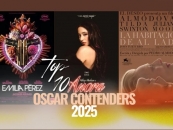-853X543.jpg)
HOLLYWOOD: CINEMA & SPACE, WOODY ALLEN'S NEW YORK
by Sharad Raj June 25 2024, 12:00 am Estimated Reading Time: 5 mins, 0 secsNew York and Woody Allen are synonyms one can safely say and the vast Central Park, where Woody Allen would take rounds for decades, is their common lungs, writes Sharad Raj.
New York is a city of Broadway musicals and the Avant Garde at the same time. From Bolero to Jazz and from Beethoven to bagels and cheesecake, you will find all under one sky of New York. It is a city where the twin towers once existed; it is a city where the Rockefeller Centre with the largest Christmas tree in the US competes with the Empire State Building; it a city where Hogs & Heifers have “bra” as its theme and women dance to a state of dizzy before many of them throw their bras on the “bra wall”, even Julia Roberts had once thrown her bra there; it is the city of beggars and strippers at the gentlemen clubs, where Russians, Hungarians and Latin Americans seek attention; it is the city where neon and LEDs light up the Times Square and fashion lovers jostle for space on the 5th Avenue; it is the city of the finest pizzas at Grimaldi’s and steaks at Peter Luger, diners and hot dog carts; it is the city of Andy Warhol and Jackson Pollock, Duke Ellington and Louis Armstrong; it is the city of laughter clubs and art house movie theatres; it is the city where you can be privileged to see Al Pacino on stage; it is the city of the iconic Brooklyn Bridge immortalized by the filmmaker who has come to be the personification of New York, Woody Allen.
10.jpg)
Many makers of high quality like Martin Scorsese, Francis Ford Coppola and Spike Lee have filmed New York in their very own interesting ways but none loves the city and belongs to it both physically and spiritually the way Woody Allen does. Today Woody Allen stays in Europe largely but once upon a time he refused to attend the Cannes Film Festival for he could not imagine leaving New York. New York and Woody Allen are synonyms one can safely say and the vast Central Park, where Woody Allen would take rounds for decades, is their common lungs.
Allen plays the clarinet at a bar with a jazz band in Hotel Carlyle in Manhattan, a hotel once frequented by John F. Kennedy. He is inextricably linked to the space that he inhabits, and space is one of the pillars of cinematic form, which in Allen’s case has been internalized. His is an insider’s gaze hence his films are devoid of any iota of a “touristy” look that many west coast filmmakers are often tempted to when they lens the city. If at all, as in Annie Hall Diane Keaton and Woody Allen are framed with the Brooklyn Bridge looming large over them it is to provide a spatial and cultural context to the neurosis of both its protagonists. The city oversees Alvy Singer and Annie while they grapple with their romantic life and midlife crisis.
Lensing of the films may not be didactic or “showing as telling” but sometimes “telling” in Woody Allen’s films shows a lot. His films are heavy on dialogue, but the spoken word is supremely cinematic in Woody Allen’s mise en scene. For instance, the famous Annie Hall dialogue about Los Angeles, “where the only culture is a free left turn.”
Trailer of the film Annie Hall
Allen’s films are endeavours of critiquing one and all. He deprecates himself, his neurotic personality, loathes pedestrian popular culture, academia, Hollywood and American culture. From the famous opening piece to the camera in Annie Hall where he paraphrases Groucho Marx and says he would not like to be a member of a club that has him as his member and his hypochondria in the film to his continuous pushing away of her teenage lover in Manhattan, Woody Allen’s look is as much inwards as it is outward, for he unabashedly accepts in the body of his greatest works that he is as much a product of American culture, as say a bottle of Heinz ketchup or Coca Cola! Just that he is a living, throbbing, thinking and an aware artist. So Allen is not only the embodiment of New York but New York also embodies him, his Brooklyn Jewish paranoia notwithstanding. For what would Woody be if he did not hear “chew” as “Jew”(Annie Hall) and did not critique Richard Wagner.
Other than Woody Allen one can only think of Jean-Luc Godard who brings in a plethora of references from philosophy, literature and other art forms into his films. That they were friends and mutually admired each other is common knowledge. Allen even acted in Godard’s King Lear.
Woody Allen is deeply obsessed with death much like Ingmar Bergman who he deeply admired and called him the greatest filmmaker alive in his film Manhattan and Federico Fellini whose film he fervently defends in Annie Hall. Allen has regularly paid homage to Bergman and Fellini but three of his films are his very specific homage to the two masters. Interiors and Love and Death are where Woody Allen doffs his hat to Bergman and to Federico Fellini in Stardust Memories.
So, a visit to New York would have been incomplete without at least meeting the master. And I took several rounds of Central Park to see if I was lucky to see him. Finally, it was a visit to Cotton Club for an evening of Jazz and soul food where I met an Austrian-German admirer of Indian soap operas and Woody Allen, who then guided me to Hotel Carlyle. And there I was sitting on a bar stool in an oversized borrowed suit, absorbing and clicking every moment of the performance of the master right in front of me!




-173X130.jpg)
-173X130.jpg)
-173X130.jpg)




-173X130.jpg)